Why are mushrooms growing in my yard? This question often arises when homeowners discover a cluster of fungi popping up in their lawns or gardens. While some may see mushrooms as a nuisance, they are actually a sign of a healthy ecosystem.
Mushrooms are a natural part of the decomposition process, breaking down organic matter and enriching the soil.
The appearance of mushrooms in your yard is a result of several factors, including the presence of organic matter, moisture, and favorable temperatures. Mushrooms thrive in environments rich in decaying wood, leaves, and other organic materials. They also require adequate moisture to germinate and grow, making areas with frequent watering or damp soil ideal habitats.
Understanding the conditions that favor mushroom growth can help you manage their presence in your yard.
Understanding Mushroom Growth
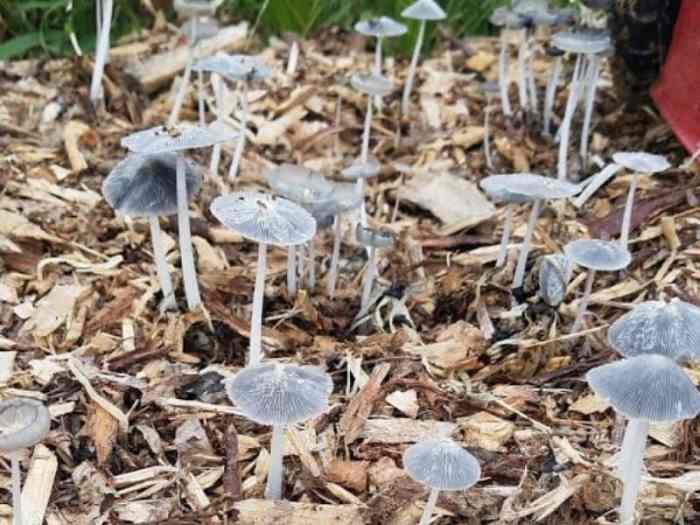
Mushrooms, those intriguing fungal organisms, often appear in yards, adding a touch of mystery and sometimes even concern to the landscape. Understanding the factors that contribute to their growth is crucial for managing their presence in your yard.
The Biology of Mushrooms
Mushrooms are the fruiting bodies of fungi, the visible reproductive structures that emerge from a network of underground hyphae. These hyphae, resembling tiny threads, form a vast interconnected network called mycelium, which spreads through the soil, absorbing nutrients and water.
When conditions are favorable, the mycelium produces mushrooms, releasing spores that can travel and colonize new areas.
Essential Conditions for Mushroom Growth
Mushrooms thrive in specific environments, requiring a combination of factors to flourish:
Moisture
Mushrooms require a consistently moist environment to thrive. They absorb water through their hyphae, and excessive dryness can inhibit their growth.
Temperature
Different mushroom species have optimal temperature ranges for growth. Some prefer cooler temperatures, while others thrive in warmer conditions.
Organic Matter
Mushrooms are saprotrophs, meaning they obtain their nutrients from decaying organic matter. They break down wood, leaves, and other plant debris, playing a vital role in decomposition. The presence of ample organic matter in the soil provides a rich source of nutrients for mushroom growth.
Common Types of Yard Mushrooms
Mushrooms found in yards can vary depending on the region and local conditions. Here are some examples of common types:
Button Mushrooms (Agaricus bisporus)
Button mushrooms are a popular edible species often found in lawns and gardens. They have white caps and stems and are commonly cultivated for consumption.
Mushrooms popping up in your yard can be a sign of rich soil, but they can also indicate a potential problem with drainage. If you’re considering adding plants around your pool, it’s essential to choose species that won’t disrupt the water quality or create slippery surfaces.
Plants to avoid around a pool include those with invasive root systems or that shed leaves and debris. Once you’ve addressed any drainage issues, you can enjoy your lush lawn, even with a few mushrooms popping up now and then.
Oyster Mushrooms (Pleurotus ostreatus)
Oyster mushrooms, named for their oyster-shaped caps, are often found growing on decaying wood, such as logs and stumps. They have a distinctive white or grayish color and are known for their delicate flavor.
Chanterelles (Cantharellus cibarius)
Chanterelles are prized edible mushrooms with a distinctive funnel-shaped cap and bright yellow or orange color. They often grow in deciduous forests and can sometimes be found in yards with ample tree cover.
Identifying the Mushroom Species

Identifying the specific type of mushroom growing in your yard is crucial for determining whether they are safe to handle or consume. Many mushroom species are harmless, while others can be poisonous or even deadly. Proper identification is essential for ensuring your safety and the safety of your family and pets.
Importance of Proper Identification
Proper mushroom identification is crucial for determining if a mushroom is edible or poisonous. Many mushroom species look similar, and even experienced mushroom hunters can make mistakes. Consuming a poisonous mushroom can lead to severe illness or even death.
“Never eat a wild mushroom unless you are absolutely certain of its identity.”
Mushrooms popping up in your yard can be a sign of a healthy ecosystem, but they can also indicate a hidden issue. One common cause is decomposing organic matter, like fallen leaves or wood. To keep your yard tidy and prevent fungal growth, consider removing any dead plant material, including the spent blooms of your lilies.
Regularly deadheading lilies helps maintain their health and prevents the buildup of decaying material that can attract fungi. This practice, combined with proper soil drainage, can help minimize those pesky mushroom appearances.
Resources for Mushroom Identification
Several resources can help you identify the mushroom species growing in your yard. These resources include:
- Field Guides:Field guides provide detailed descriptions and illustrations of various mushroom species. They often include information on the mushroom’s habitat, seasonality, and edibility. Popular field guides include “Mushrooms Demystified” by David Arora and “National Audubon Society Field Guide to North American Mushrooms” by Gary Lincoff.
- Online Databases:Online databases offer a wealth of information on mushroom identification. Websites like MushroomExpert.com and MykoWeb.com provide detailed descriptions, photographs, and identification keys. Some websites also allow users to submit photos of mushrooms for identification by experts.
- Local Mycological Societies:Local mycological societies often host mushroom identification workshops and field trips. These events provide opportunities to learn from experienced mushroom hunters and identify mushrooms in their natural habitat.
Using Field Guides for Identification, Why are mushrooms growing in my yard
When using a field guide, carefully examine the mushroom’s features, including:
- Cap:Note the cap’s shape, color, texture, and presence of any scales or warts.
- Gills:Observe the gills’ color, attachment to the stem, and spacing.
- Stem:Examine the stem’s length, thickness, color, and presence of a ring or volva.
- Spore Print:A spore print can be a helpful identification tool. To create a spore print, place the mushroom cap, gills down, on a piece of white paper. Cover the cap with a bowl or glass and leave it undisturbed for several hours.
The spores will fall onto the paper, creating a colored print.
- Habitat:Note the type of environment where the mushroom is growing, such as a forest, field, or lawn.
- Seasonality:Some mushroom species only appear during specific seasons.
Using Online Databases for Identification
Online databases can be a valuable resource for mushroom identification. Some websites allow users to upload photos of mushrooms and receive identification assistance from experts. When using online databases, ensure the website is reputable and provides accurate information.
Safety Precautions
When identifying mushrooms, it is essential to take safety precautions:
- Never eat a wild mushroom unless you are absolutely certain of its identity.
- If you are unsure about a mushroom’s identity, do not touch it.Some mushrooms can cause skin irritation or allergic reactions.
- Keep children and pets away from wild mushrooms.
Causes of Mushroom Growth in Yards: Why Are Mushrooms Growing In My Yard
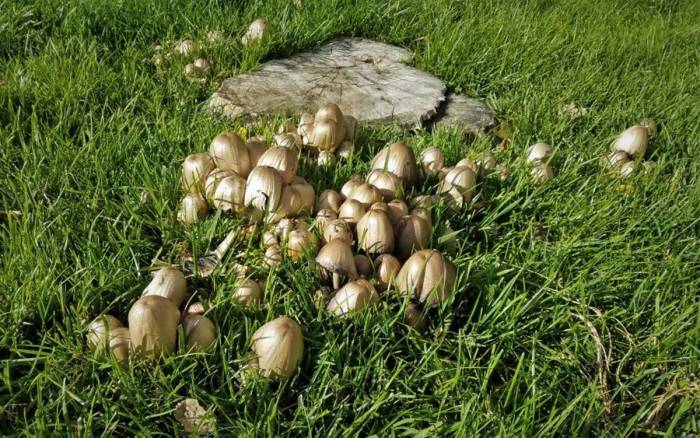
Mushrooms thrive in environments rich in organic matter, and common yard practices often create these ideal conditions. Understanding these factors can help you manage mushroom growth in your yard.
Yard Practices Contributing to Mushroom Growth
Many common yard practices, intentionally or unintentionally, provide the necessary resources for mushrooms to flourish.
- Mulching:Mulch, composed of organic materials like wood chips, shredded leaves, or bark, provides a rich source of nutrients for mushrooms. This organic matter decomposes, releasing essential nutrients that mushrooms require for growth.
- Composting:Compost piles are essentially mini ecosystems teeming with decomposers, including mushrooms. The breakdown of organic waste in compost bins creates a favorable environment for mushroom growth. Mushrooms often appear near compost piles, utilizing the readily available nutrients.
- Watering:Consistent watering, particularly in areas with organic matter, creates a moist environment that mushrooms need for germination and growth. Excess moisture can also lead to the decomposition of organic matter, further promoting mushroom growth.
Role of Decaying Organic Matter
Mushrooms are saprophytic organisms, meaning they obtain nutrients by breaking down dead organic matter. This process, known as decomposition, is crucial for recycling nutrients back into the ecosystem.
- Decaying Wood:Mushrooms, particularly wood-decaying fungi, readily colonize and break down dead wood, releasing nutrients back into the soil. This process is essential for the natural cycle of forest ecosystems.
- Leaves:Fallen leaves provide a rich source of organic matter for mushrooms. As leaves decompose, they release nutrients that support mushroom growth. This is why you often see mushrooms growing in areas with leaf litter.
- Other Organic Matter:Mushrooms can also thrive on decaying grass clippings, animal droppings, and other organic debris. These materials provide a source of carbon, nitrogen, and other essential nutrients that fuel mushroom growth.
Environmental Factors Influencing Mushroom Growth
Beyond organic matter, several environmental factors can influence mushroom growth.
- Soil pH:Mushrooms have specific pH preferences. Some species prefer acidic soils, while others thrive in alkaline soils. Soil pH can affect the availability of nutrients, influencing mushroom growth.
- Drainage:Mushrooms require moisture but can be negatively impacted by excessive waterlogging. Well-drained soil allows for proper aeration and prevents the accumulation of water, which can hinder mushroom growth.
- Temperature:Mushrooms have optimal temperature ranges for growth. While some species can tolerate colder temperatures, others prefer warmer conditions. Temperature fluctuations can impact mushroom development.
Managing Mushroom Growth
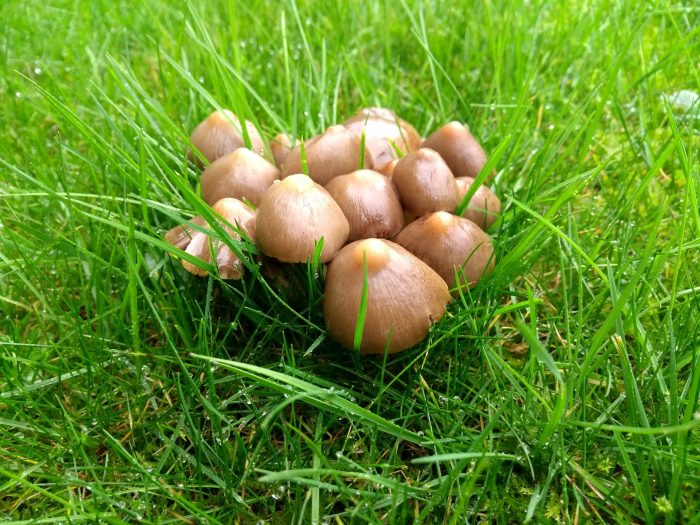
While mushrooms are fascinating and sometimes even desirable in the wild, their presence in your yard can be a nuisance, especially if they are growing in unwanted areas. Managing mushroom growth involves addressing the underlying causes and implementing appropriate control measures.
Removing Organic Matter
Mushrooms thrive on decomposing organic matter, so removing their food source is a key step in controlling their growth.
- Remove decaying wood:If mushrooms are growing near stumps, logs, or other decaying wood, remove or dispose of these materials.
- Clear leaf litter:Regularly rake up fallen leaves and other organic debris from your lawn and garden.
- Compost properly:If you compost, ensure that your compost pile is well-aerated and does not become too wet.
Adjusting Watering Practices
Mushrooms prefer moist environments. By adjusting your watering practices, you can make your yard less hospitable to them.
- Water deeply but less often:Deep watering encourages deep root systems, which are less susceptible to fungal growth.
- Avoid overwatering:Overwatering creates a constantly moist environment that mushrooms love.
- Water in the morning:This allows the soil to dry out during the day, reducing the moisture levels mushrooms prefer.
Using Fungicides
In cases of persistent mushroom growth, fungicides can be used as a last resort. However, it’s crucial to consider the potential impact on the environment and your overall ecosystem.
- Choose organic fungicides:Organic fungicides are derived from natural sources and are generally less harmful to beneficial organisms.
- Apply with caution:Follow the instructions on the fungicide label carefully, and apply it only to the affected areas.
- Consider alternative methods:Before resorting to fungicides, explore other methods of managing mushroom growth, as they may be more environmentally friendly.
Alternative Methods
Besides removing organic matter and adjusting watering practices, other methods can help manage mushroom growth.
- Introduce beneficial organisms:Certain beneficial fungi and bacteria can compete with mushroom-causing fungi. You can introduce these organisms through compost tea or by adding beneficial fungi to your soil.
- Promote healthy lawn practices:A healthy lawn is more resistant to fungal growth. This includes proper fertilization, mowing, and aeration.
Potential Benefits of Mushrooms in Yards
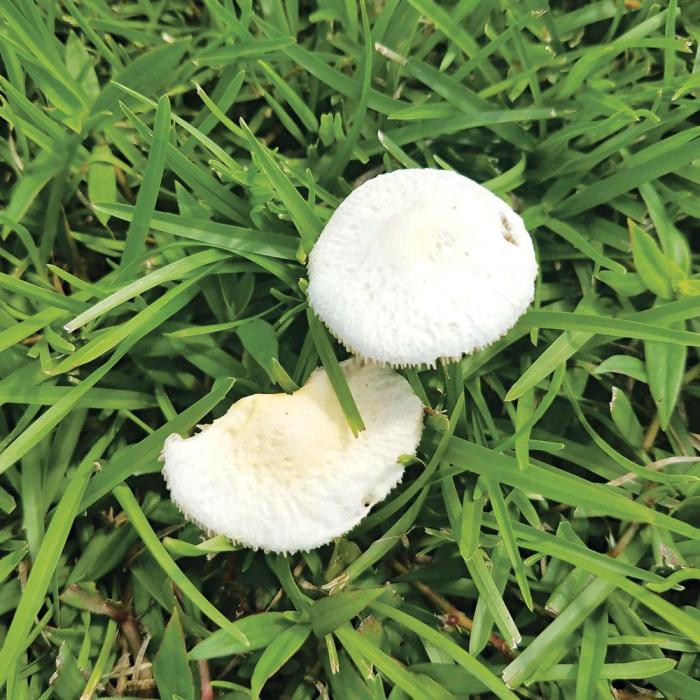
While mushrooms might seem like an unwelcome guest in your yard, they actually play a crucial role in maintaining a healthy ecosystem. These fascinating fungi are not just decomposers; they also contribute to soil fertility and support plant growth in various ways.
Ecological Role of Mushrooms in Decomposition
Mushrooms are nature’s recyclers, breaking down dead plant and animal matter into simpler compounds. This process, known as decomposition, releases essential nutrients back into the soil, enriching it for future plant growth. Mushrooms are particularly effective at breaking down complex organic matter like wood, leaves, and even animal carcasses, which would otherwise take years to decompose.
Without these decomposers, our ecosystems would be overwhelmed with dead organic matter, hindering plant growth and disrupting the delicate balance of nature.
Beneficial Interactions with Plants: Mycorrhizal Fungi
Some mushroom species form mutually beneficial relationships with plants, known as mycorrhizal associations. Mycorrhizal fungi are a type of fungi that colonize plant roots, extending their reach into the soil. These fungi act as an extension of the plant’s root system, absorbing water and nutrients from the soil more efficiently.
In return, the plant provides the fungi with sugars produced through photosynthesis. This symbiotic relationship benefits both partners, leading to healthier and more robust plants.
Mushrooms in Sustainable Gardening Practices
Mushrooms can be incorporated into sustainable gardening practices, promoting a healthier and more eco-friendly approach to growing food.
- Compost Starters:Mushrooms can be used as compost starters, accelerating the decomposition process and producing nutrient-rich compost. Mushrooms release enzymes that break down organic matter, leading to faster compost maturation.
- Bioremediation Agents:Certain mushroom species can be used for bioremediation, the process of cleaning up contaminated soil or water. Some mushrooms have the ability to break down pollutants like pesticides, herbicides, and heavy metals, effectively detoxifying the environment.
Closure
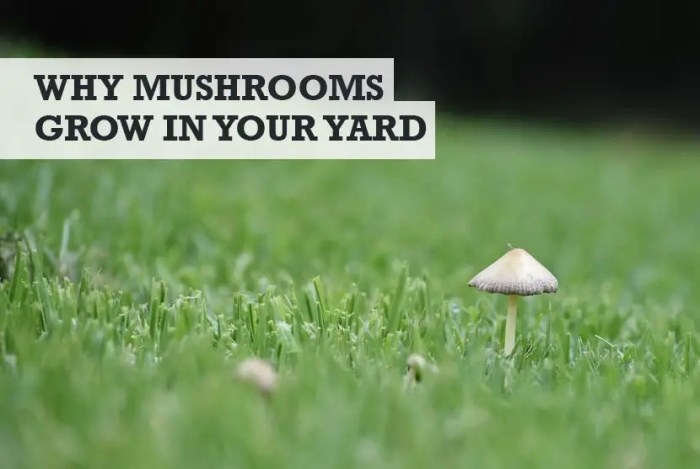
Mushrooms, while often seen as an unwelcome sight in yards, play a crucial role in maintaining a healthy ecosystem. Their presence indicates a thriving environment rich in organic matter and moisture. By understanding the factors that contribute to their growth and implementing appropriate management strategies, you can control their appearance while appreciating their ecological significance.
Whether you choose to embrace their presence or manage their growth, remember that mushrooms are a fascinating part of the natural world.